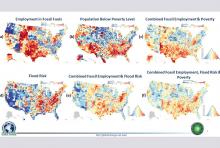Nonmethane Hydrocarbon Chemistry in the Remote Marine Atmosphere
We examine nonmethane hydrocarbon chemistry in the remote marine boundary layer theoretically and experimentally, with particular emphasis place on the role it may play in hydroxly radical (OH) chemistry. A photochemical model is used to consider the role the nonmethane hydrocarbons (NMHC) may have in the remote marine boundary layer, with (contradictory) constraints supplied by published observations of NMHC in the boundary layer and dissolved in ocean water. The atmospheric observations suggest a spectrum of roles for the NMHC in OH chemistry, ranging from secondary significance through primary importance as OH sinks and even approaching a governing role as dominant sources and sinks of OH. It is not possible to tell whether the range represents true variability or variable data quality. The oceanic observations suggest a much less important role, with NMHC fluxes to the atmosphere (and thus concentrations) roughly ten times lower than the low end of the range suggested by the atmospheric observations. Possibilities for this disagreement are discussed, though it is unclear whether the data are reliable enough to call into question current ideas about air-sea gas exchange. The experimental work begins with the development of absolute NMHC standards up to C5 alkanes and alkenes. Finally, we describe our participation in the SAGA 3 expedition to the central Pacific in February – March, 1990, where we observed NMHC both in the atmosphere and the ocean. Our data continues to show the disagreement between air and water observations described above, and both our air and water data fall at the low ends of previous ranges. It is argued that the higher atmospheric observations probably reflect systematic problems with canister sampling, leading us to conclude that the role of NMHC in the remote atmospheric OH budget is indeed secondary though important, accounting (in conjunction with NMHC oxidation products) for 10 to 20% of all OH removal. The disparity between oceanic and atmospheric observations may be real, but enough uncertainty remains in the observations to prevent firm conclusions.


